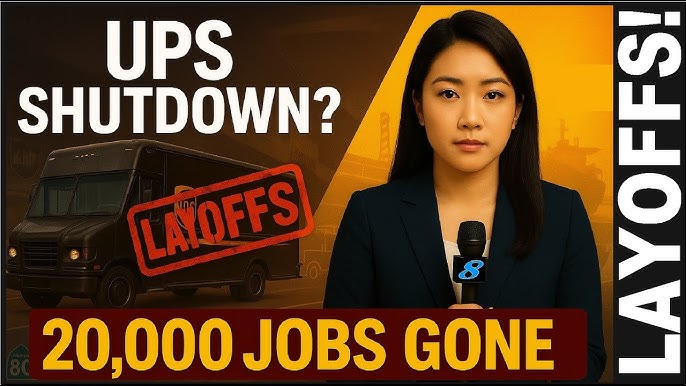UPS Layoffs Amazon: The Deep Impact of Corporate Restructuring and Shifting Logistics Partnerships
Table of Contents
- Introduction
- Understanding the Relationship Between UPS and Amazon
- Why UPS Is Laying Off Employees in 2024–2025
- How Amazon’s Evolving Logistics Affected UPS
- Key Figures: Layoffs, Facility Closures, and Cost Cutting
- Impacts on UPS Employees and Labor Unions
- Effects on the Logistics Industry
- Technology and Automation: Double-Edged Sword
- UPS’s Strategic Shift Towards Higher-Margin Business
- How These Changes Reflect Larger Global Trends
- Responses from Stakeholders and Public
- Potential Future Scenarios
- What This Means for Other Courier Services
- How Communities Are Being Affected
- UPS and Amazon: What Happens Next?
- Conclusion
1. Introduction
In 2024, UPS (United Parcel Service) announced massive layoffs and facility closures, sending shockwaves through the logistics and e-commerce ecosystem. The most alarming catalyst? A significant drop in shipping volume from Amazon, its long-time partner. This article unpacks the multifaceted reasons behind the restructuring, how it ties to Amazon’s evolving strategy, and the broader implications for the global labor market and logistics sector.
2. Understanding the Relationship Between UPS and Amazon
For years, Amazon has been one of UPS’s largest customers, accounting for a notable percentage of its delivery volume—peaking at nearly 15%. UPS helped Amazon build its delivery empire, especially during the boom in e-commerce during the pandemic. However, over time, this relationship became strained as Amazon started building its own logistics network (Amazon Logistics), reducing its dependency on external carriers like UPS and FedEx.
Amazon’s move to deliver more of its own packages meant fewer parcels for UPS to handle, especially in residential areas where last-mile delivery is expensive.
3. Why UPS Is Laying Off Employees in 2024–2025
In early 2025, UPS revealed its plan to lay off 12,000–20,000 employees and close 73 facilities. The reasons are complex but include:
- Reduced Amazon Shipping Volume: A 50%+ drop in volume from Amazon between 2021–2024
- Economic Pressures: Rising costs and declining profit margins
- Overcapacity: Too much infrastructure relative to current demand
- Operational Restructuring: Moving toward a more centralized, efficient network
4. How Amazon’s Evolving Logistics Affected UPS
Amazon is rapidly evolving. It now delivers more than 70% of its own U.S. packages, up from just 20% in 2018. This shift had massive implications for UPS:
- Reduced Volume: Lower package volume from a once-dominant customer
- Increased Competition: Amazon is now a direct logistics competitor
- Pricing Power Shift: UPS lost leverage in negotiating contracts
This evolution forced UPS to rethink its operations and scale down to align with post-pandemic demand realities.
5. Key Figures: Layoffs, Facility Closures, and Cost Cutting
UPS’s announcement in 2024 includes:
- 12,000 to 20,000 Layoffs globally
- 73 facilities closing as part of network consolidation
- $3.5 billion cost-cutting goal for 2025
- $400–$600 million in severance and restructuring charges
While the financial restructuring aims to stabilize profitability, the human impact is enormous—thousands are losing their jobs, especially in middle-management and fulfillment center roles.
6. Impacts on UPS Employees and Labor Unions
6.1 Worker Displacement
The UPS layoffs have led to massive job losses, particularly in hubs that were once busy due to Amazon parcel volumes. Workers face:
- Job insecurity
- Limited alternative employment in some rural areas
- Emotional and financial strain
6.2 Union Reactions
The Teamsters Union, which represents a significant portion of UPS workers, has condemned the layoffs and is pushing back. UPS’s move came shortly after a new labor agreement that raised wages—raising suspicions that cost-cutting measures are partly retaliatory.
7. Effects on the Logistics Industry
The UPS-Amazon layoffs is a microcosm of larger industry shifts:
- Increased Vertical Integration: Amazon is now competing with third-party shippers
- Emergence of New Players: Startups and regional carriers are growing
- Labor Market Instability: Gig work vs. full-time logistics jobs
- Technology Investments: Automation is replacing humans
UPS’s restructuring is setting a precedent for how other logistics giants may react to market turbulence.
8. Technology and Automation: Double-Edged Sword
8.1 Benefits for Companies
- Lower long-term labor costs
- Enhanced delivery speed and accuracy
- Improved scalability
8.2 Consequences for Workers
- Widespread job displacement
- Upskilling requirements
- Diminishing labor bargaining power
As UPS transitions into more automated fulfillment, fewer human workers are needed—a trend mirrored across the industry.
9. UPS’s Strategic Shift Towards Higher-Margin Business
UPS under CEO Carol Tomé has refocused on a “better, not bigger” strategy:
- Targeting high-margin clients like healthcare and SMEs
- Limiting low-profit Amazon shipments
- Investing in route optimization software
- Expanding UPS Healthcare and UPS Premier
While strategically sound, this approach also leads to reduced workforce needs and downsizing of infrastructure.
10. How These Changes Reflect Larger Global Trends
UPS’s actions are a reflection of several macroeconomic and industrial trends:
- E-commerce normalization post-COVID
- Remote work and hybrid fulfillment models
- Economic uncertainty and inflation
- Shift from globalization to regionalization
These changes are pushing companies to become leaner, more automated, and more selective about the clients they serve.
11. Responses from Stakeholders and Public
11.1 Investors
Investors largely approved of UPS’s cost-cutting strategy, with UPS stock seeing temporary gains.
11.2 Employees
Morale has taken a hit, especially among long-time workers who feel betrayed.
11.3 Public Perception
While the public is somewhat sympathetic to workers, many are unaware of the deeper dynamics at play behind corporate decisions.
12. Potential Future Scenarios
- Scenario A: Amazon Fully Exits Third-Party Logistics
- UPS may continue downsizing
- Rivals like FedEx and DHL could benefit
- Scenario B: UPS Shifts to Premium Clientele
- Higher margins but reduced market share
- Scenario C: Consolidation in the Delivery Market
- Fewer but more powerful players dominate
13. What This Means for Other Courier Services
UPS’s restructuring has ripple effects:
- FedEx is already undergoing similar cost-cutting
- Regional carriers might capture Amazon’s excess volume
- Gig economy couriers like DoorDash and Uber may absorb last-mile delivery overflow
The industry is in flux, and adaptability will determine long-term survival.
14. How Communities Are Being Affected
In places where UPS facilities are closing:
- Local economies are being strained
- Municipal tax revenues are shrinking
- Increased unemployment is triggering social support needs
Some cities are lobbying UPS to slow closures or offer retraining programs.
15. UPS and Amazon: What Happens Next?
Though their relationship may continue at a reduced scale, UPS and Amazon are clearly diverging. The future may involve:
- Continued Amazon logistics expansion
- UPS focusing on specialized delivery markets
- Possible re-entry negotiations during peak seasons (e.g., holidays)
UPS has hinted that Amazon is now more of a “competitor than a customer.”
16. Conclusion
The “UPS layoffs Amazon” event is a dramatic but telling example of how technology, corporate strategy, and macroeconomic forces collide. UPS’s decision to downsize is about survival in a post-Amazon-dominated world, but it brings significant social and economic costs.
As logistics continues to evolve, the only constant is change—and those who adapt fastest will lead the next era of global commerce.







